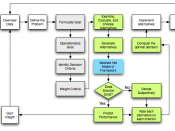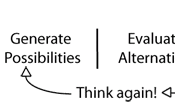Ethical Decision-Making Model
In the individual assignment for workshop one, the students are required to describe a decision-making model and identify the steps of their chosen model. The students are then asked to relate the decision-making model to a job-related decision they have recently made. They must also describe how critical thinking impacted the decision. The model chosen for this paper is ethical decision-making.
According to Ethic's Resource Center, there are six steps to ethical decision making. These steps include,
o Step One: Define the problem PLUS,
o Step Two: Identify the alternatives,
o Step Three: Evaluate the alternatives PLUS,
o Step Four: Make the decision,
o Step Five: Implement the decision,
o Step Six: Evaluate the decision PLUS (Ethic's Resource Center, 2003).
The most significant step in the decision-making process is step one. Step one, defining the problem, refers to the procedure that describes "why a decision is called for and identifying the most desired outcome(s) of the decision making process" (Ethic's Resource Center, 2003, p.
2). The easiest way to decide if a problem exists is to phrase the problem in terms of what one wanted or expected of the actual situation.
In this way a problem is defined as the difference between expected and/or desired outcomes and actual outcomes. This careful attention to definition in terms of outcomes allows one to clearly state the problem. This is a critical consideration because how one defines a problem determines how one defines causes and where one searches for solutions. (Ethic's Resource Center, 2003, p. 2)
The second step in the decision-making model is identifying available alternative solutions to the problem. The key to this step is to not impose boundaries upon oneself. Without self imposed boundaries, alternatives choices to the problem become obvious and we become open to...



Comment
Good essay. You brought up many good points.
3 out of 3 people found this comment useful.